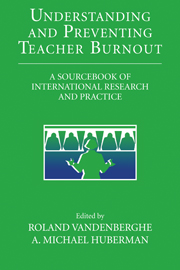Book contents
- Frontmatter
- Contents
- Contributors
- List of Figures
- List of Tables
- Foreword
- Introduction: Burnout and the Teaching Profession
- PART ONE TEACHER BURNOUT: A CRITICAL REVIEW AND SYNTHESIS
- 1 The Nomological Network of Teacher Burnout: A Literature Review and Empirically Validated Model
- 2 Stress and Burnout in the Teaching Profession: European Studies, Issues, and Research Perspectives
- 3 Teacher Stress in a Time of Reform
- 4 Teacher Burnout: A Critical Challenge for Leaders of Restructuring Schools
- 5 Intensification and Stress in Teaching
- 6 Reframing Teacher Burnout in the Context of School Reform and Teacher Development in the United States
- PART TWO TEACHER BURNOUT: PERSPECTIVES AND REMEDIES
- PART THREE TEACHER BURNOUT: A RESEARCH AND INTERVENTION AGENDA
- References
- Index
2 - Stress and Burnout in the Teaching Profession: European Studies, Issues, and Research Perspectives
Published online by Cambridge University Press: 06 January 2010
- Frontmatter
- Contents
- Contributors
- List of Figures
- List of Tables
- Foreword
- Introduction: Burnout and the Teaching Profession
- PART ONE TEACHER BURNOUT: A CRITICAL REVIEW AND SYNTHESIS
- 1 The Nomological Network of Teacher Burnout: A Literature Review and Empirically Validated Model
- 2 Stress and Burnout in the Teaching Profession: European Studies, Issues, and Research Perspectives
- 3 Teacher Stress in a Time of Reform
- 4 Teacher Burnout: A Critical Challenge for Leaders of Restructuring Schools
- 5 Intensification and Stress in Teaching
- 6 Reframing Teacher Burnout in the Context of School Reform and Teacher Development in the United States
- PART TWO TEACHER BURNOUT: PERSPECTIVES AND REMEDIES
- PART THREE TEACHER BURNOUT: A RESEARCH AND INTERVENTION AGENDA
- References
- Index
Summary
Introduction
Stress and burnout are phenomena that are becoming increasingly problematic. Whereas teacher stress has been an issue for some time, burnout is gaining importance. Being a social helper, the teacher is particularly affected by stress and burnout. The data on incidence of stress and burnout in the teaching profession show that in Western and Eastern countries, about 60% to 70% of all teachers repeatedly show stress symptoms and at least 30% of all teachers show distinct burnout symptoms (see Borg and Falzon, 1989; Brenner, 1982; Capel, 1992; Koleva, 1985; Kyriacou, 1980; Kytaev-Smyk, 1983; Müller-Limmroth, 1980; Temml, 1994).
Consequences of Stress and Burnout
This frequency is particularly serious because of the consequences. Stress and burnout have an influence on the following phenomena in particular.
Sickness Rate. The sickness rate of teachers is determined by neurotic and psychosomatic disorders (compare Rudow, 1995) in which stress plays a prominent role. Typical symptoms for burnout are fatigue, sleeping disorders, depression, and abuse of alcohol or drugs.
Absence. The sickness rate results in a high absence rate of teachers. However, we need to distinguish here between temporary and permanent absence. Temporary absence – short and repeated absences – occurs mainly in stress situations, often in the beginning phase of burnout. Continuous absences can be observed more in burnout phases.
Early Retirement. Burnout is a developing process, so highly distinct symptoms of performance weakness and fatigue do not generally appear until a person has spent fifteen to twenty years on the job.
- Type
- Chapter
- Information
- Understanding and Preventing Teacher BurnoutA Sourcebook of International Research and Practice, pp. 38 - 58Publisher: Cambridge University PressPrint publication year: 1999
- 82
- Cited by

